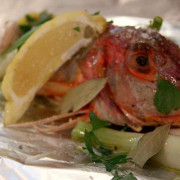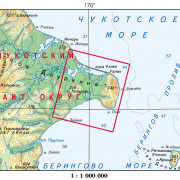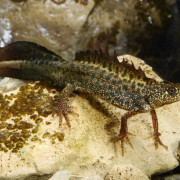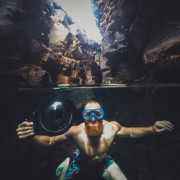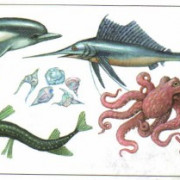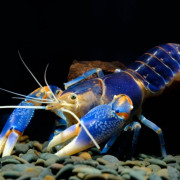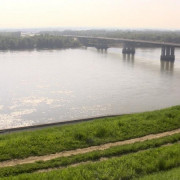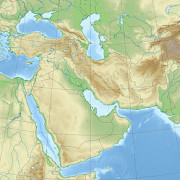Пугающие монстры прошлого 14 фото 13 гиф
Опис

Череп Dunkleosteus, , Париж, Франція
Dunkleosteus мав відносно добре, як для девонських тварин, розвинені (хоча перші щелепні з’явилися ще в ). Замість зубів у нього були великі кісткові пластини, корисні для роздроблення панцира інших плакодерм. При вивченні в біомеханічної комп’ютерної моделі щелеп Dunkleosteus було визначено, що вони могли розвивати тиск в 55 М, а це можна порівняти з укусом . Більш того, Dunkleosteus міг відкривати рот за 1/50 секунди, в результаті чого потік води просто засмоктував в нього жертву.
Рештки Dunkleosteus часто виявляються поряд із пережованими кістками. Припускається, що він подібно до інших плакодерм міг відригувати ті кістки, які не міг переварити.
Description
Life restoration of D. marsaisi
The largest species, D. terrelli, is estimated to have grown up to 6 m (20 ft) in length and 1 t (1.1 short tons) in weight, making it one of the largest placoderms to have existed. Like other placoderms, Dunkleosteus had a two-part bony, armoured exterior, which may have made it a relatively slow but powerful swimmer. Instead of teeth, Dunkleosteus possessed two pairs of sharp bony plates which formed a beak-like structure.Dunkleosteus, together with most other placoderms, may have also been among the first vertebrates to internalize egg fertilization, as seen in some modern sharks.
A skull diagram of Dunkleosteus
Mainly the armoured frontal sections of specimens have been fossilized, and consequently the appearance of the other portions of the fish is mostly unknown. In fact, only about 5% of Dunkleosteus specimens have more than a quarter of their skeleton preserved. Because of this, many reconstructions of the hindquarters are often based on smaller arthrodires, such as Coccosteus, which had preserved hind sections. However, an exceptionally preserved specimen of D. terrelli preserves ceratotrichia in a pectoral fin, implying that the fin morphology of placoderms was much more variable than previously thought, and was heavily influenced by locomotory requirements. This knowledge, coupled with the knowledge that fish morphology is more heavily influenced by feeding niche than phylogeny, allowed a 2017 study to infer the body shape of D. terrelli. This new reconstruction gives D. terrelli a much more shark-like profile, including a strong anterior lobe on its tail, in contrast to reconstructions based on other placoderms.
The most famous specimens of Dunkleosteus are displayed at the Cleveland Museum of Natural History, and others are displayed at the American Museum of Natural History, National Museum of Natural History, State Museum of Pennsylvania, Harrisburg and in the Queensland Museum in Brisbane, Queensland.[citation needed]
Diet
Life restoration of D. terrelli
Dunkleosteus terrelli possessed a four-bar linkage mechanism for jaw opening that incorporated connections between the skull, the thoracic shield, the lower jaw and the jaw muscles joined together by movable joints. This mechanism allowed D. terrelli to both achieve a high speed of jaw opening, opening their jaws in 20 milliseconds and completing the whole process in 50–60 milliseconds (comparable to modern fishes that use to assist in prey capture;) and producing high bite forces when closing the jaw, estimated at 6,000 N (612 kgf; 1,349 lbf) at the tip and 7,400 N (755 kgf; 1,664 lbf) at the blade edge in the largest individuals. The pressures generated in those regions were high enough to puncture or cut through cuticle or dermal armor suggesting that D. terrelli was adapted to prey on free-swimming, armored prey such as ammonites and other placoderms. Fossils of Dunkleosteus are frequently found with boluses of fish bones, semidigested and partially eaten remains of other fish. As a result, the fossil record indicates it may have routinely regurgitated prey bones rather than digest them. It probably inhabited inshore waters.[citation needed]
Juveniles
Morphological studies on the lower jaws of juveniles of D. terrelli reveal they were proportionally as robust as those of adults, indicating they already had the ability to produce high bite forces and likely were able to shear into resistant prey tissue similar to adults, albeit on a smaller scale. This pattern is in direct contrast to the condition common in tetrapods in which the jaws of juveniles are more gracile than in adults.
Taxonomy
Restoration and size comparison of D. terrelli
Dunkleosteus was named in 1956 to honour David Dunkle, then curator of vertebrate paleontology at the Cleveland Museum of Natural History. The type species D. terrelli was originally described in 1873 as a species of Dinichthys. Dunkleosteus is an arthrodire originally placed in the family Dinichthyidae, which is composed mostly of large, carnivorous fish like Gorgonichthys. Anderson (2009) suggests, because of its primitive jaw structure, Dunkleosteus should be placed outside the family Dinichthyidae, perhaps close to the base of the clade Pachyosteomorpha, near Eastmanosteus. Carr and Hlavin (2010) resurrect Dunkleosteidae and place Dunkleosteus, Eastmanosteus, and a few other genera from Dinichthyidae within it. Dinichthyidae, in turn, is made into a monospecific family.
Species
D. marsaisi skull
At least 10 different species of Dunkleosteus have been described so far.
The type species, D. terrelli, is the largest, best-known species of the genus. It has a rounded snout. D. terrelli‘s fossil remains are found in Upper Frasnian to Upper Famennian Late Devonian strata of the United States (Huron and Cleveland Shale of Ohio, the Conneaut of Pennsylvania, Chattanooga Shale of Tennessee, Lost Burro Formation, California, and possibly Ives breccia of Texas) and Europe.
D. belgicus (?) is known from fragments described from the Famennian of Belgium. The median dorsal plate is characteristic of the genus, but, a plate that was described as a suborbital is apparently an anteriolateral plate.
D. denisoni is known from a small median dorsal plate, typical in appearance for Dunkleosteus, but much smaller than normal.
D. marsaisi refers to the Dunkleosteus fossils from the Lower Famennian Late Devonian strata of the Atlas Mountains in Morocco. It differs in size, the known skulls averaging a length of 35 centimetres (1.15 ft) and in form to D. terrelli. In D. marsaisi, the snout is narrower, and a postpineal fenestra may be present. Many researchers and authorities consider it a synonym of D. terrelli. H. Schultze regards D. marsaisi as a member of Eastmanosteus.
D. magnificus is a large placoderm from the Frasnian Rhinestreet Shale of New York. It was originally described as «Dinichthys magnificus» by Hussakof and Bryant in 1919, then as «Dinichthys mirabilis» by Heintz in 1932. Dunkle and Lane moved it to Dunkleosteus in 1971.
D. missouriensis is known from fragments from Frasnian Missouri. Dunkle and Lane regard them as being very similar to D. terrelli.
D. newberryi is known primarily from a 28 centimetres (11 in) long infragnathal with a prominent anterior cusp, found in the Frasnian portion of the Genesee Group of New York, and originally described as «Dinichthys newberryi«.
D. amblyodoratus is known from some fragmentary remains from Late Devonian strata of Kettle Point, Canada. The species name means «blunt spear» and refers to the way the nuchal and paranuchal plates in the back of the head form the shape of a blunted spearhead. Although it is known only from fragments, it is estimated to have been about 6 metres (19.7 ft) long in life.
D. raveri is a small species, possibly 1 meter long, known from an uncrushed skull roof found in a carbonate concretion from near the bottom of the Huron Shale, of the Famennian Ohio Shale strata. Besides its small size, it had comparatively large eyes. Because D. raveri was found in the strata directly below the strata where the remains of D. terrelli are found, D. raveri may have given rise to D. terrelli. The species name commemorates Clarence Raver of Wakeman, Ohio, who discovered the concretion where the holotype was found.
Описание
 Dunkleosteus «intermedius» (D. terrelli)
Dunkleosteus «intermedius» (D. terrelli)
Дунклеостеи имели достаточно развитые (хотя первые челюстные появились ещё в ). Вместо зубов у них были большие костные пластины для дробления панциря беспозвоночных или других плакодерм. При изучении в биомеханической компьютерной модели челюстей дунклеостея определили, что они могли развивать давление в 5 , а это сопоставимо с укусом . Более того, дунклеостеи открывали рот за 1/50 секунды, в результате чего поток воды просто засасывал в него жертву.

Пластиковая модель Dunkleosteus
дунклеостеев часто обнаруживаются рядом с пережёванными костями. Предполагается, что он, подобно остальным плакодермам, отрыгивал те кости, которые не мог переварить.

